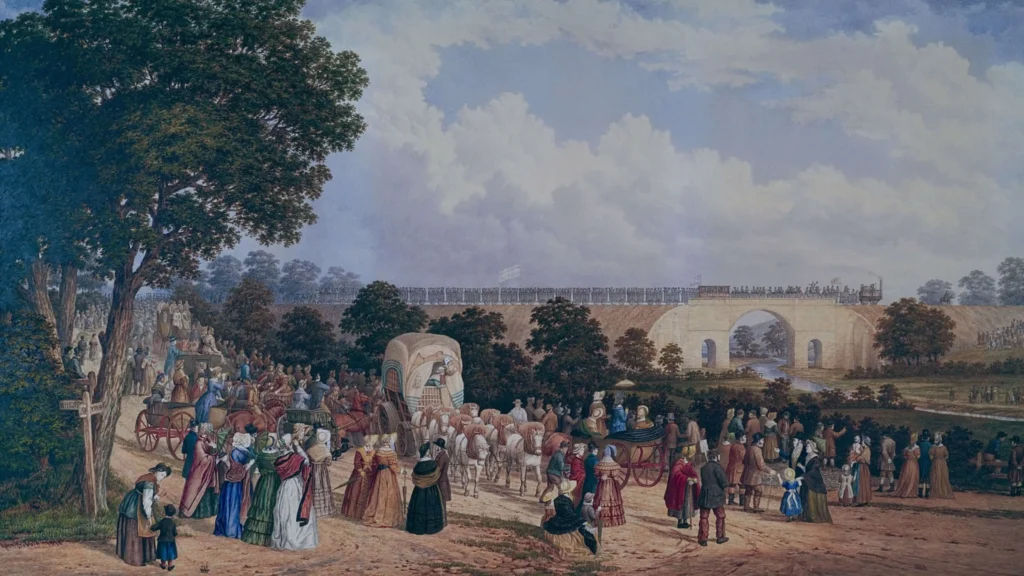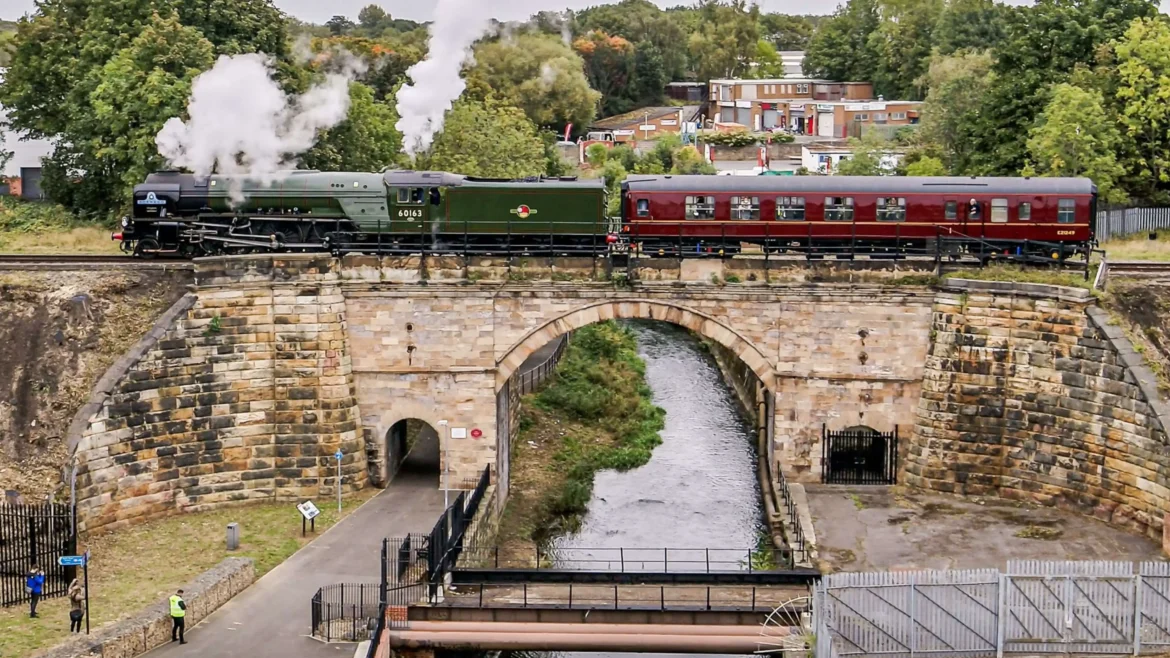Skerne Bridge, located in Darlington, County Durham, is one of the most important monuments in the history of the railway. Though modest in size and appearance when compared to some of the grander viaducts and bridges built later in the nineteenth century, it holds a distinction that makes it truly unique: it is the world’s oldest surviving railway bridge in continuous use. Built for the Stockton and Darlington Railway in 1825, Skerne Bridge has come to symbolise the dawn of the railway age and the transformation of transport, industry, and society that railways brought to the world.
This essay will explore the history, design, significance, and legacy of Skerne Bridge, highlighting why this seemingly unassuming stone structure deserves such a prominent place in global industrial heritage.
The Historical Context: Stockton and Darlington Railway
To understand Skerne Bridge, it is essential to place it in the context of the Stockton and Darlington Railway (S&DR). In the early nineteenth century, Britain was undergoing rapid industrialisation. Coal from the mines of County Durham and Northumberland was in high demand, not only locally but across the country and for export. The challenge lay in transporting this coal efficiently from the mines inland to ports such as Stockton-on-Tees.
Traditional methods relied on horse-drawn wagons along wooden or iron plateways, or on canals. These systems, while effective to a degree, had limitations in terms of cost, speed, and capacity. By the early 1820s, the idea of using locomotives to haul wagons on iron rails was gaining momentum, spurred by experiments in places such as Tyneside, where engineers like George Stephenson had demonstrated the potential of steam power.
The Stockton and Darlington Railway, authorised by an Act of Parliament in 1821 and later amended in 1823, was the brainchild of Edward Pease, a Darlington Quaker and industrialist. The line would run from Witton Park near Bishop Auckland to Stockton, with branches serving collieries. Stephenson, appointed as the chief engineer, was instrumental in shaping its design and advocating for steam locomotion rather than horse traction.
The railway opened on 27 September 1825, an event often described as the “birth of the modern railway.” George Stephenson himself drove the inaugural train, pulled by his locomotive Locomotion No. 1. On that day, thousands of people witnessed a spectacle that would change history: steam-hauled wagons carrying both coal and passengers over a purpose-built railway.
Among the engineering works along the line was Skerne Bridge, designed to carry the railway across the River Skerne near Darlington.
Construction of Skerne Bridge
Skerne Bridge was designed by Ignatius Bonomi (1787–1870), an architect and surveyor based in Durham who came from an Italian family. Bonomi worked on various civil engineering and architectural projects across northern England, and in this case, he was tasked with producing a practical yet durable bridge to allow the new railway to cross the modest River Skerne.
Completed in time for the railway’s grand opening in 1825, the bridge was built from local stone. It is a simple, single-span, semi-circular arch bridge, with approach embankments leading up to it. Although not large, its proportions were carefully considered to bear the weight of coal wagons and locomotives, which, though relatively light compared to later trains, were heavy enough to require a robust design.
The bridge was constructed by local masons and labourers, employing traditional techniques. The arch was formed with voussoirs, wedge-shaped stones that transfer the load into the abutments. The parapets were finished with coping stones, giving the bridge a neat and functional appearance. Importantly, Skerne Bridge was among the first railway bridges built specifically for steam locomotives, marking it as a pioneering structure.
The Opening Day and Iconic Image
Skerne Bridge gained immediate fame through its appearance in one of the most iconic images of the railway age. The artist John Dobbin painted a scene of the Stockton and Darlington Railway’s opening day in 1825, showing crowds of spectators, wagons loaded with coal and passengers, and Stephenson’s Locomotion No. 1 crossing the bridge.

This painting has since become emblematic of the railway revolution. Though the image is somewhat romanticised, it immortalises Skerne Bridge as a witness to a defining moment in industrial history. Today, the original painting is preserved in the National Railway Museum in York, and countless reproductions have spread the image worldwide.
Later Modifications
As railway technology developed rapidly in the nineteenth century, the trains using the Stockton and Darlington Railway became larger and heavier. Skerne Bridge, while adequate for the early years, soon required strengthening. In 1829, just four years after its completion, reinforcements were added to the bridge to increase its capacity. Later, further modifications were carried out in the mid-nineteenth century.
Despite these changes, the essential structure of the bridge has remained intact, preserving its original form and character. Unlike many other early railway structures, which were replaced or demolished as demands increased, Skerne Bridge survived thanks to careful maintenance and adaptation. Its endurance is a testament both to the skill of its original builders and to the respect accorded to it as a historic landmark.
Heritage Status and Preservation
By the twentieth century, Skerne Bridge was recognised as a structure of exceptional historical importance. In 1950, it was granted Grade I listed status, placing it among the most protected buildings in the United Kingdom. English Heritage has described it as “the world’s oldest railway bridge still in use.”
The bridge continues to carry trains today, though the line it serves has been altered over time. While the Stockton and Darlington Railway was absorbed into larger railway companies during the nineteenth century and eventually into British Rail, the section through Darlington remains part of the operational network. Modern trains, far larger and heavier than anything envisaged in 1825, still rumble over Skerne Bridge daily, a remarkable continuity of use spanning two centuries.
In 2025, the bicentenary of the Stockton and Darlington Railway will be celebrated, and Skerne Bridge is expected to play a central role in commemorations. Local authorities, heritage organisations, and railway enthusiasts view the bridge as a symbol not only of the North East’s industrial heritage but of Britain’s role in pioneering global railway technology.
Symbolism and Global Legacy
Skerne Bridge symbolises more than just a functional piece of infrastructure. It embodies the beginning of a transport revolution that reshaped the world. Railways enabled the rapid movement of goods, resources, and people on an unprecedented scale. They accelerated industrial growth, urbanisation, and global trade. They transformed landscapes, economies, and societies.
When looking at Skerne Bridge today, one is reminded of the modest origins of this revolution. Unlike later feats of Victorian engineering—such as the Ribblehead Viaduct in Yorkshire, the Britannia Bridge in Wales, or the Forth Bridge in Scotland—Skerne Bridge is small and understated. Yet, its importance lies precisely in being first. It represents the initial step in a process that would see railway networks span continents and connect nations.
For railway enthusiasts and historians worldwide, Skerne Bridge is a pilgrimage site. It links directly back to the moment when the railway age began, a physical relic of an era that changed the trajectory of modern history.
Community and Cultural Importance
The bridge is also significant to the people of Darlington and the wider Tees Valley. The Stockton and Darlington Railway placed the town at the forefront of industrial innovation and gave it a unique role in global history. As such, Skerne Bridge is a source of civic pride and identity. Local schools, museums, and heritage groups often use it as an educational tool to teach younger generations about their area’s contribution to world progress.
Events and celebrations regularly highlight the bridge, and it features in local art, literature, and tourism. Visitors to Darlington are often encouraged to see the bridge as part of a broader heritage trail that includes Head of Steam – Darlington Railway Museum (now being redeveloped as part of the 2025 bicentenary), the preserved trackbed of the Stockton and Darlington line, and other associated structures.
Conclusion
Skerne Bridge may not be grand in scale, but its significance is monumental. As the world’s oldest surviving railway bridge in continuous use, it is a physical link to the very birth of the railway age. Designed by Ignatius Bonomi and completed in 1825 for the Stockton and Darlington Railway, it witnessed the inaugural run of Locomotion No. 1 and the dawn of a new era in transport.
Its survival and continued use for almost two centuries reflect both the strength of its construction and the reverence with which it has been treated. More than just a bridge over a small river in Darlington, Skerne Bridge stands as a symbol of innovation, progress, and the industrial revolution.
In 2025, as the world commemorates 200 years since the Stockton and Darlington Railway first opened, Skerne Bridge will once again be at the heart of celebrations. It remains, quite literally, a bridge between past and present, carrying trains and stories across the centuries.

